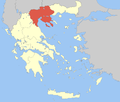Central Macedonia
Central Macedonia
Κεντρική Μακεδονία | |
|---|---|
Administrative region | |
 | |
| Coordinates: 40°42′N 23°00′E / 40.7°N 23.0°E | |
| Country | |
| Region | |
| Decentralized administration | Macedonia and Thrace |
| Capital | Thessaloniki |
| Regional units | |
| Government | |
| • Regional Governor | UTC+3 (EEST) |
| ISO 3166 code | GR-B |
| HDI (2019) | 0.876[3] very high · 6th of 13 |
| Website | www |
Central Macedonia (/ˌmæsəˈdoʊniə/ MASS-ə-DOH-nee-ə; Greek: Κεντρική Μακεδονία, romanized: Kentrikí Makedonía, IPA: [ce(n)driˈci maceðoˈni.a]) is one of the thirteen administrative regions of Greece, consisting of the central part of the geographical and historical region of Macedonia. With a population of almost 1.8 million, it is the second most populous region in Greece after Attica.
Geography
The region of Central Macedonia is situated in
Administration
The region was established in the 1987 administrative reform as the Central Macedonia Region (
Although geographically part of Central Macedonia, Mount Athos is not administratively part of the region, but an autonomous self-governing state under the sovereignty of Greece.
Demographics
The region has shrunk by 90,039 people between 2011 and 2021, experiencing a population loss of 4.8%.[1][4]
History
The
Economy
In 2011, the
Tourism
Central Macedonia is Greece's fourth-most-popular tourist region and the most popular destination that is not an
Major cities and towns
References
- ^ a b "Census 2021 GR" (PDF) (Press release). Hellenic Statistical Authority. 2022-07-19. Retrieved 2022-09-12.
- ^ "Population on 1 January by age, sex and NUTS 2 region", www.ec.europa.eu
- ^ "Sub-national HDI - Area Database - Global Data Lab". hdi.globaldatalab.org. Retrieved 2021-07-20.
- ^ "Σε 10.432.481 υπολογίζεται ο πληθυσμός της Ελλάδας - Είμαστε 383.805 λιγότεροι σε σχέση με το 2011 (βίντεο)". Macedonia Newspaper (in Greek). Retrieved 2023-07-14.
- ^ "Gross domestic product (GDP) at current market prices at NUTS level 2". Eurostat regional yearbook. Eurostat. Retrieved 3 April 2015.
- ^ "Greece in Figures 2018". Hellenic Statistical Authority.
- Discover Greece. Retrieved 2019-02-09.
- ^ "Γαλάζιες Σημαίες 2018" [Blue Flags 2018]. www.eepf.gr. Retrieved 2019-02-10.
- ^ "Macedonia travel – Greece". Lonely Planet. Retrieved 2019-02-09.
External links
- Official website
 (in Greek)
(in Greek)


